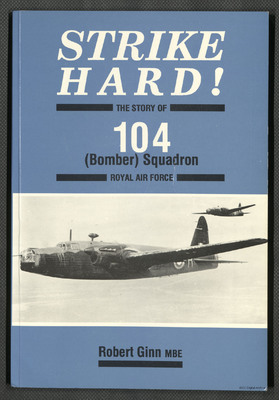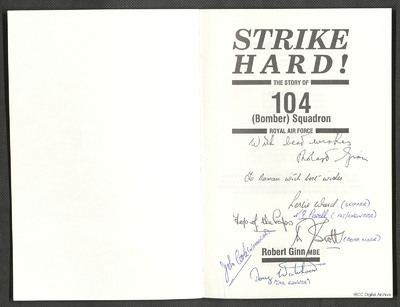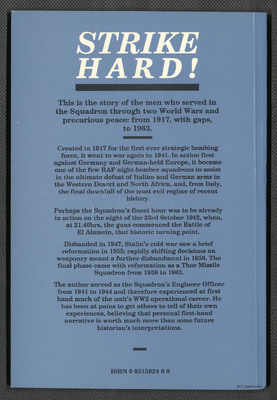Strike hard - the story of 104 (bomber) squadron
Title
Strike hard - the story of 104 (bomber) squadron
Description
Front cover with photograph of two Wellington airborne in formation. Inside front cover with signatures. The book which covers from formation of squadron in 1917, Second World War and post war history up to 1963.
This item is available only at the International Bomber Command Centre / University of Lincoln.
This item is available only at the International Bomber Command Centre / University of Lincoln.
Creator
Coverage
Language
Type
Format
Printed book
Conforms To
Publisher
Rights
This content is available under a CC BY-NC 4.0 International license (Creative Commons Attribution-NonCommercial 4.0). It has been published ‘as is’ and may contain inaccuracies or culturally inappropriate references that do not necessarily reflect the official policy or position of the University of Lincoln or the International Bomber Command Centre. For more information, visit https://creativecommons.org/licenses/by-nc/4.0/ and https://ibccdigitalarchive.lincoln.ac.uk/omeka/legal.
Contributor
Identifier
MPowellNI1896919-191029-31
Transcription
STRIKE HARD!
THE STORY OF 104 (Bomber) Squadron
Royal Air Force
[photograph]
Robert Ginn MBE
[page break]
[blank page]
[page break]
STRIKE HARD!
THE STORY OF 104 (Bomber) Squadron
ROYAL AIR FORCE
With best wishes Robert Ginn
To Norman with best wishes
Leslie Ward. (SKIPPER)
N. I. Powell (FLT/ENGINEER)
Top of the Pops [?]
[indecipherable letter] Scott (BOMB AIMER)
John Coole (W/OPERATOR)
Doug Watchour (TAIL GUNNER)
Robert Ginn MBE
[page break]
STRIKE HARD!
This is the story of the men who served in the Squadron through two World Wars and precarious peace: from 1917, with gaps, to 1963.
Created in 1917 for the first ever strategic bombing force, it went to war again in 1941. In action first against Germany and German-held Europe, it became one of the few RAF night-bomber squadrons to assist in the ultimate defeat of Italian and German arms in the Western Desert and North Africa, and, from Italy, the final downfall of the most evil regime of recent history.
Perhaps the Squadron's finest hour was to be already in action on the night of the 23rd October 1942, when, at 21.40hrs, the guns commenced the Battle of El Alamein, that historic turning point.
Disbanded in 1947, Stalin's cold war saw a brief reformation in 1955; rapidly shifting decisions on weaponry meant a further disbandment in 1956. The final phase came with reformation as a Thor Missile Squadron from 1959 to 1963.
The author served as the Squadron's Engineer Officer from 1941 to 1944 and therefore experienced at first hand much of the unit's WW2 operational career. He has been at pains to get others to tell of their own experiences, believing that personal first-hand narrative is worth much more than some future historian's interpretations.
ISBN 0 9515924 0 8
THE STORY OF 104 (Bomber) Squadron
Royal Air Force
[photograph]
Robert Ginn MBE
[page break]
[blank page]
[page break]
STRIKE HARD!
THE STORY OF 104 (Bomber) Squadron
ROYAL AIR FORCE
With best wishes Robert Ginn
To Norman with best wishes
Leslie Ward. (SKIPPER)
N. I. Powell (FLT/ENGINEER)
Top of the Pops [?]
[indecipherable letter] Scott (BOMB AIMER)
John Coole (W/OPERATOR)
Doug Watchour (TAIL GUNNER)
Robert Ginn MBE
[page break]
STRIKE HARD!
This is the story of the men who served in the Squadron through two World Wars and precarious peace: from 1917, with gaps, to 1963.
Created in 1917 for the first ever strategic bombing force, it went to war again in 1941. In action first against Germany and German-held Europe, it became one of the few RAF night-bomber squadrons to assist in the ultimate defeat of Italian and German arms in the Western Desert and North Africa, and, from Italy, the final downfall of the most evil regime of recent history.
Perhaps the Squadron's finest hour was to be already in action on the night of the 23rd October 1942, when, at 21.40hrs, the guns commenced the Battle of El Alamein, that historic turning point.
Disbanded in 1947, Stalin's cold war saw a brief reformation in 1955; rapidly shifting decisions on weaponry meant a further disbandment in 1956. The final phase came with reformation as a Thor Missile Squadron from 1959 to 1963.
The author served as the Squadron's Engineer Officer from 1941 to 1944 and therefore experienced at first hand much of the unit's WW2 operational career. He has been at pains to get others to tell of their own experiences, believing that personal first-hand narrative is worth much more than some future historian's interpretations.
ISBN 0 9515924 0 8
Collection
Citation
Robert Ginn MBE, “Strike hard - the story of 104 (bomber) squadron,” IBCC Digital Archive, accessed October 29, 2024, https://ibccdigitalarchive.lincoln.ac.uk/omeka/collections/document/39260.
Item Relations
This item has no relations.



